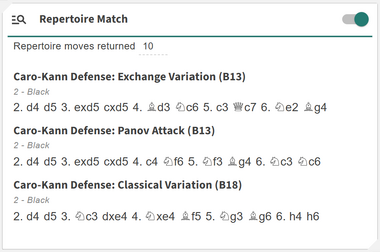Repertoire Match: Difference between revisions
From Repertoire Builder
More actions
HollowLeaf (talk | contribs) No edit summary |
HollowLeaf (talk | contribs) No edit summary |
||
| (5 intermediate revisions by the same user not shown) | |||
| Line 1: | Line 1: | ||
[[File:AnalyticsCards-RepertoireMatch.png|thumb|380px]] | |||
'''Available in:''' Builder, Library, Practice, Tools | '''Available in:''' Builder, Library, Practice, Tools | ||
The '''Repertoire Match''' card shows whether the current board position appears in any of your other repertoires. This allows you to instantly identify overlapping positions, compare how you’ve approached the same situation across different repertoires, and maintain consistency in your overall preparation. | The '''Repertoire Match''' card shows whether the current board position appears in any of your other repertoires. This allows you to instantly identify overlapping positions, compare how you’ve approached the same situation across different repertoires, and maintain consistency in your overall preparation. You can also '''click''' on any matched repertoire to instantly navigate to that position and review how it’s played there. | ||
This feature helps you: | This feature helps you: | ||
<ul style="list-style:none; padding-left: | <ul style="list-style:none; padding-left:1.5em; margin:0;"> | ||
<li><span style="display:inline-block; width:0.9em; text-align:center; font-weight:bold;">+</span> Detect overlapping positions shared across multiple repertoires</li> | <li style="text-indent:-1.1em; padding-left:1.1em;"> | ||
<li><span style="display:inline-block; width:0.9em; text-align:center; font-weight:bold;">+</span> Compare move choices and evaluations between related repertoires</li> | <span style="display:inline-block; width:0.9em; text-align:center; font-weight:bold;">+</span> | ||
<li><span style="display:inline-block; width:0.9em; text-align:center; font-weight:bold;">+</span> Ensure consistency in how specific openings or lines are played</li> | Detect overlapping positions shared across multiple repertoires | ||
<li><span style="display:inline-block; width:0.9em; text-align:center; font-weight:bold;">+</span> Avoid conflicts or redundant lines when expanding your repertoire</li> | </li> | ||
<li style="text-indent:-1.1em; padding-left:1.1em;"> | |||
<span style="display:inline-block; width:0.9em; text-align:center; font-weight:bold;">+</span> | |||
Compare move choices and evaluations between related repertoires | |||
</li> | |||
<li style="text-indent:-1.1em; padding-left:1.1em;"> | |||
<span style="display:inline-block; width:0.9em; text-align:center; font-weight:bold;">+</span> | |||
Instantly jump to the same position within other repertoires to review differences | |||
</li> | |||
<li style="text-indent:-1.1em; padding-left:1.1em;"> | |||
<span style="display:inline-block; width:0.9em; text-align:center; font-weight:bold;">+</span> | |||
Ensure consistency in how specific openings or lines are played | |||
</li> | |||
<li style="text-indent:-1.1em; padding-left:1.1em;"> | |||
<span style="display:inline-block; width:0.9em; text-align:center; font-weight:bold;">+</span> | |||
Avoid conflicts or redundant lines when expanding your repertoire | |||
</li> | |||
</ul> | </ul> | ||
{{DocNav | |||
| prev = Repertoire Review | |||
| prev_label = Repertoire Review | |||
| next = Space Visualisation | |||
| next_label = Space Visualisation | |||
}} | |||
Latest revision as of 02:16, 15 October 2025

Available in: Builder, Library, Practice, Tools
The Repertoire Match card shows whether the current board position appears in any of your other repertoires. This allows you to instantly identify overlapping positions, compare how you’ve approached the same situation across different repertoires, and maintain consistency in your overall preparation. You can also click on any matched repertoire to instantly navigate to that position and review how it’s played there.
This feature helps you:
- + Detect overlapping positions shared across multiple repertoires
- + Compare move choices and evaluations between related repertoires
- + Instantly jump to the same position within other repertoires to review differences
- + Ensure consistency in how specific openings or lines are played
- + Avoid conflicts or redundant lines when expanding your repertoire
Prev: Repertoire Review
Next: Space Visualisation
